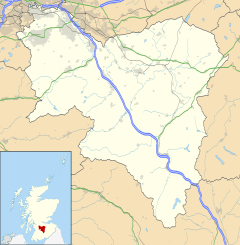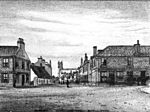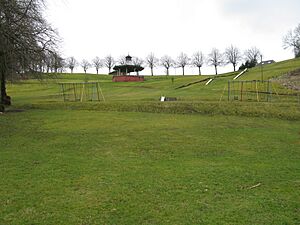Stonehouse, South Lanarkshire facts for kids
Quick facts for kids Stonehouse |
|
|---|---|
 Remains of Saint Ninian's Kirk, Stonehouse, South Lanarkshire. |
|
| Population | 5,550 (2020) |
| OS grid reference | NS755467 |
| • Edinburgh | 35+1⁄2 mi (57 km) |
| • London | 330 mi (531 km) |
| Council area | |
| Lieutenancy area | |
| Country | Scotland |
| Sovereign state | United Kingdom |
| Post town | LARKHALL |
| Postcode district | ML9 |
| Dialling code | 01698 |
| Police | Strathclyde |
| Fire | Strathclyde |
| Ambulance | Scottish |
| EU Parliament | Scotland |
| UK Parliament |
|
| Scottish Parliament |
|
Stonehouse is a village in South Lanarkshire, Scotland. It is located by the Avon Water, a beautiful river, close to the Clyde Valley. The village is on the A71 road, which connects Edinburgh and Kilmarnock. Nearby towns include Hamilton, Larkhall, and Strathaven. About 7,500 people live in Stonehouse.
Contents
History of Stonehouse
- Gallery of drawings
The oldest building in Stonehouse is the ruin of St Ninian's Church. It dates back to the 1600s and stands in an old graveyard. The village centre has many weavers' cottages from the late 1700s and early 1800s. These homes have large double windows. This was to let in more light for the weavers working on their looms.
In 1973, Stonehouse was chosen to become a "new town" in Scotland. The idea was to build more homes for people from Glasgow who lived in crowded areas. It also aimed to create new jobs. Other new towns like East Kilbride and Livingston were built for similar reasons. However, in 1976, the plan for Stonehouse was stopped. Only 96 houses were built. The government decided to focus on improving Glasgow's city centre instead.
Cot Castle: A Fortified Home
Cot Castle was more like a strong, fortified house than a large castle. These types of buildings, called "keeps" or "tower houses," were common in Scotland. They were smaller than English castles but offered safety and comfort. They were easier for Scots to defend during wars with England. Cot Castle was built on a cliff by the River Avon, which helped protect it.
Not much is known about the castle's early history. It often changed owners when battles were lost. However, we know that the Hamilton family owned it around the year 1500. A document from 1511-12 mentions Alexander Hamilton of Catcastell selling some land nearby. The Cot Castle farm, built much later, is now in ruins. A railway station was also once located here.
Holy Wells and Their Meaning
In ancient times, four holy wells were found in Stonehouse. These wells were important in pagan beliefs. Later, they might have been used for Christian baptisms. The 19th-century writer Thomas Carlyle noted that the old German word for 'holy' (heilig) also meant 'healthy'. He believed that 'holy' truly meant 'completely healthy'.
Richard Naismith, a local historian, thought these wells were seen as special. People believed the water had healing powers. Pilgrims would travel to try the water's properties. One such well was located between the churchyard and Eastmains farm.
Ringsdale Castle: An Ancient Mound
Ringsdale Castle was not a stone castle but a "motte." A motte is a raised earth mound that once held a wooden fort. Its remains can still be seen on a high mound overlooking the Avon Gorge. The name Ringsdale might come from an old Celtic word meaning 'promontory' or 'hill'. Near Ringsdale, there was also a mill called Cloxy Mill. Its ruins can still be seen by the Avon River.
Other Castles in the Area
Several other castles or castle sites are found near Stonehouse. These include Allanton, Brocket, Plotcock, Glassford, and Darngaber motte. The farm of Castlehill may also have been named after an old castle. Some think it might have been a fort built by the Romans.
Covenanter Memorials: Remembering Brave Scots
In the 1600s, Scottish Presbyterians called Covenanters disagreed with the English king's church rules. This led to fighting. The area around Stonehouse saw some of these conflicts. The Battle of Drumclog was fought on June 1, 1679, about 9 miles (14 km) southwest of Stonehouse. James Thomson from Stonehouse Parish died from his injuries in this battle. He is buried in St. Ninian's churchyard, which has other Covenanter graves. In 1880, about 2,000 people gathered at St. Ninian's to remember the battle.
Another small fight happened at Sodom Hill, about 10 miles (16 km) northeast of Stonehouse. This was a clash between Covenanters and the king's troops. A song called "In Praise of the Avon" mentions this battle: "Sodom Hill and Drumclog Field Where weavers fought and wadna yield; Where Scotland’s richts were firmly seal’d Beside the winding Avon."
Three weeks later, the Covenanter cause ended in Lanarkshire at the Battle of Bothwell Bridge. This site is about 10 miles (16 km) north of Stonehouse. In 1903, a monument was dedicated there, with about 25,000 people attending.
Schools in Stonehouse
Stonehouse has two modern primary schools: Stonehouse Primary and Newfield Primary. Most children from these schools go to Larkhall Academy for high school. Some children attend Strathaven Academy. The local Catholic primary school is St. Patrick's Primary School in Strathaven.
Transport Links
Roads for Travel
Stonehouse is on the A71 road, which goes between Edinburgh and Kilmarnock. A bypass was built around the old village to make traffic flow better. The village is also close to the M74 motorway. This motorway connects Stonehouse to Glasgow and other towns to the north. It also links to Dumfries and Galloway and England to the south.
Bus Services
Stonehouse has regular bus services. Whitelaw's Coaches provides service 254 to nearby towns like Larkhall, Hamilton, East Kilbride, and Strathaven. Buses run often during the day and hourly in the evenings and on Sundays.
Railways: Past and Present
The railway line through Stonehouse closed in 1965. There were two lines, one to Dalserf and another to Strathaven. Today, the closest train station for Stonehouse is at Larkhall. The local council has looked into extending the railway from Larkhall to Stonehouse. However, there are challenges, like a missing viaduct and the A71 bypass built over the old track.
Sports and Recreation
Alexander Hamilton Memorial Park
The Alexander Hamilton Memorial Park opened in 1925. It was a gift from Alexander Hamilton, a local man who became rich making carpets. The park's unique bandstand came from an exhibition in Glasgow in 1911. The park offers great views over the Avon Valley.
A long park chute (slide) was built into the hillside in 1933 but was removed in 1967. Today, the park has a floodlit athletics track and a football pitch. It also has a multi-surface games area, woodland walks, and play areas.
Tileworks Sports Ground
The Tileworks sports ground has a floodlit all-weather playing surface. It can be used for football or tennis. The facility also has indoor changing rooms. It has a full-size grass pitch used by local football clubs.
Stonehouse Bowling Club
The bowling club was first started in 1857. It later moved to its current location on Vicars Road.
Buildings of Interest in Stonehouse
Churches in Stonehouse
Stonehouse has two main churches: St. Ninian's Church and Paterson United Free Church of Scotland. St. Ninian's Church was built in 1896. It replaced an older church from 1772. In 1929, it was renamed St Ninian's Parish Church of Scotland.
The ruins of the original St Ninian’s church are in its cemetery off Manse Road. People have worshipped and been buried on this site since the 400s. The oldest gravestone dates back to the 11th or 12th century.
Paterson United Free Church of Scotland was built in 1879. It was renamed to honour H. A. Paterson, a minister who died in 1901.
Stonehouse Senior Citizens Hall
This hall used to be the Gas Office. It is in the village square at Stonehouse Cross. It once shared the building with Stonehouse Library. The library is now in the South Lanarkshire Lifestyles Centre.
Stonehouse Public Institute
The institute was once the Miners Welfare Hall. It was built in the early 1900s on New Street. It is used for many events and concerts. A small part of the building was also a local radio studio.
Stonehouse Public Hall
This hall was built in the late 1800s at Trongate, near Stonehouse Cross.
South Lanarkshire Lifestyles - Stonehouse
New community centre opened in 2011. It replaced older public buildings. It has a library, a café, and a learning centre. Rooms can be booked for learning sessions, fitness classes, and parenting groups.
Rex Cinema: A Unique Past
The Rex Cinema opened in Argyle Street in 1937. It was owned by John Edward Sheeran. This cinema was special because it was decorated with furnishings from a famous cruise liner, the RMS Homeric. Sheeran bought parts of the ship's luxurious interior at an auction in 1935. He used them to decorate the 750-seat cinema. You can still see some of the original doors, a mahogany staircase, a large chandelier, and wall panels from the ship's first-class restaurant.
Cemeteries and War Memorials
Stonehouse Cemetery holds the village's war memorial. It lists the names of 8 British service members who died in the World Wars. Their graves are looked after by the Commonwealth War Graves Commission. Other cemeteries in the village include St. Ninian's Church Cemetery and Glebe Cemetery.
The Stonehouse War Memorial is a cross on a tall base. It stands in the middle of Stonehouse Cemetery. Names of soldiers from World War I are on one side. Names from World War II are on the other side.
Bridges of Stonehouse
Linthaugh Bridge crosses the Avon Water. It was built in 1772. Another important bridge is the Stonehouse Viaduct.
Countryside Around Stonehouse
Two rivers flow through the area: Avon Water and Cander Water. Nearby hills include Grossyet Knowe and Sodom Hill.
Cander Moss Nature Reserve
Cander Moss is a special nature reserve. It is a remaining part of a large raised bog. The Scottish Wildlife Trust looks after it. This area is home to many types of wildlife that live in bog habitats. However, there are no easy footpaths, so it can be hard to walk across.
Hospitals in Stonehouse
Stonehouse Hospital first opened in 1896. It cared for people with tuberculosis and other diseases. It was known as "the best isolation hospital in Scotland." The old Victorian building was replaced. A new hospital opened in May 2004.
Community Groups and Organisations
Stonehouse Heritage Group
The Stonehouse Heritage Group (SHG) started in 1991. It was formed by volunteers. Their first project was to put census information about Stonehouse into a computer. This made it easy to search for names and addresses. The group now has a resource room at the Stonehouse Lifestyles community hall. You can find more information on their website.
Stonehouse Scouts, Cubs and Beavers
Scouting in Stonehouse stopped in the early 1990s but restarted in 2014. Local volunteers helped bring it back. Now, there is a lively group that offers challenges and activities for boys and girls aged 6 to 14. The groups meet at the Scout and Guide Hall in Lawrie Street. The older Scouts meet on Monday evenings, Beavers on Wednesday evenings, and Cubs on Fridays. You can find full details on their website.
|
See also
 In Spanish: Stonehouse (South Lanarkshire) para niños
In Spanish: Stonehouse (South Lanarkshire) para niños













